More than 100 Wabash men spent their spring break in Immersion Learning Courses. Immersion learning is one component of the classroom experience which adds great depth and meaning to text, classroom lectures, and the educational experience. Most students are required to prepare a paper on something they will see in South America, Europe, or in the United States.
Below is a small sampling of the student blogs from the immersion trips. It is not all inclusive but a glimpse of the impact of Wabash’s Immersion learning program. These are the words our Wabash students, unedited and insightful. More than 30 student blogs were written about the various trips, you can see those here.
Rome with Classics Professor Jeremy Hartnett
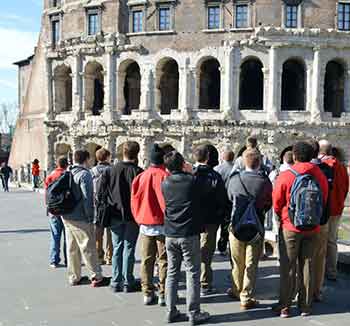 “Before coming to Rome, we had learned the importance of Rome in its power as a city and as an important symbol for the emergence and growth of early Christianity. I had not truly appreciated the historical significance of the various pieces of architecture and what they told about the emperors, early Christian figures, and even the everyday normal folk of the empire.
“Before coming to Rome, we had learned the importance of Rome in its power as a city and as an important symbol for the emergence and growth of early Christianity. I had not truly appreciated the historical significance of the various pieces of architecture and what they told about the emperors, early Christian figures, and even the everyday normal folk of the empire.
“It is hard not to have your breath taken away when walking into the basilicas. The size of each one was absolutely massive and you could feel the power of the building before you even walk inside. As you walk inside, you feel even more overwhelmed, not only by the size, but also by the vivid Christian imagery and relics present within the building. “ – Brady Boles ‘17
“I especially was able to appreciate the ruins because I have taken four classes of Latin at Wabash College. I was able to practice this skill in the churches, signs, and all over the ruins. It was more of like a jigsaw puzzle, using what we have learned earlier in the semester as a base of knowledge, then by examining the ruins and the Latin associated to it, we could better understand what the Roman’s would have been doing here in these exact spots many years ago.” – Logan Anglin ‘17
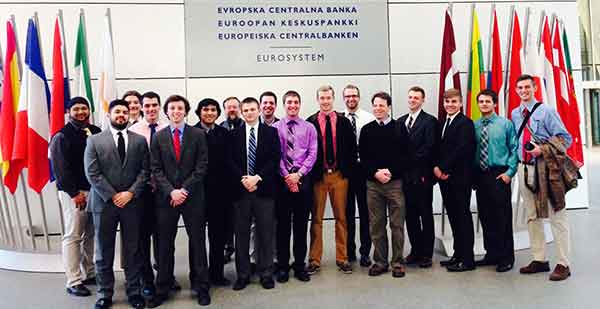
European Union with Economics Professor Peter Mikek
and Political Science Professor Ethan Hollander.
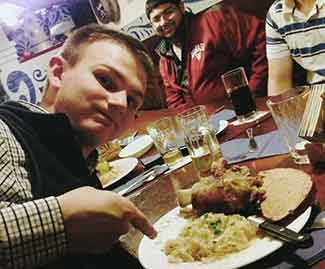 “Walking around (Frankfurt, Germany) today showed me that the term “melting pot” cannot just be used to describe the U.S. I talked to an Irishman who spoke very accented Dutch, German, and English about how Chelsea was better than Paris St. Germaine (soccer, btw). Earlier, I asked for pouille mafa (spiced chicken) in a Senegalese restaurant from a waiter who only spoke French, albeit with a little help from Professors Byun and Hollander. Though these cultures and people are very distinct, there is no denying that they mix together in this city and others across Europe. Thinking of America as the only place where cultures come together is simply closed-minded to the entire world around us.” – Ben Wade ‘17
“Walking around (Frankfurt, Germany) today showed me that the term “melting pot” cannot just be used to describe the U.S. I talked to an Irishman who spoke very accented Dutch, German, and English about how Chelsea was better than Paris St. Germaine (soccer, btw). Earlier, I asked for pouille mafa (spiced chicken) in a Senegalese restaurant from a waiter who only spoke French, albeit with a little help from Professors Byun and Hollander. Though these cultures and people are very distinct, there is no denying that they mix together in this city and others across Europe. Thinking of America as the only place where cultures come together is simply closed-minded to the entire world around us.” – Ben Wade ‘17
“It has become clear that while the E.U. may look like a train wreck from the American vantage point, there are intelligent minds guiding the monetary policy of the European Union. Like America, though, we are beginning to see where politicians take policies crafted by experts and turn them into policies that are appealing to their voters. In turn, bad policies are implemented, and in many cases, this is what Americans and the rest of the world see.
“Nonetheless, our discussions with people who live and work in Germany made it obvious that Americans are not the only people who are skeptical of the European Union. At a pub in Frankfurt, we talked with two German interns who shared their views on the European Union, the challenges it has created, and in some ways, confirmed the things we were told at the European Central Bank today. First, while the European Union may be a “nice idea,” taking dozens of existing government structures and central banking systems and placing them under the jurisdiction of a loosely defined, constitution-less governing body leads to a lot of skepticism — even more than we might see if we spent a lot of time comparing the federalist system in the United States to the attempt at federalism in the European Union.” – Seton Goddard ‘15
New York Art with Art Professor Elizabeth Morton
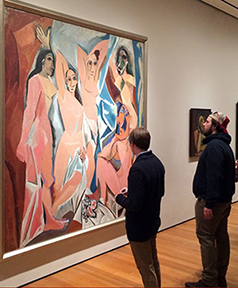 “When walking through the gallery, I turned a corner and saw this masterpiece. I instantly got cold chills. Everything I was told about this painting flooded back into my head. I instantly took a step back and snapped a picture of it. As with any painting I see, I looked at it from afar and then slowly approached it while observing the brush work that the artist used. This work by Picasso carried a lot of weight in this room and the entire museum. This was the painting I had heard about for so long and here it was in front of me. In my student work at Wabash, I used photography as my medium. After seeing this work along with other powerful paintings such as “ Starry Night” by Vincent van Gogh, I wished I had used painting as my medium. The work I saw on this trip will influence the way I approach the subject matter in my photography. These spectacular works of art were not the only things that kept us on our feet.” – Jesse Caldwell ‘15
“When walking through the gallery, I turned a corner and saw this masterpiece. I instantly got cold chills. Everything I was told about this painting flooded back into my head. I instantly took a step back and snapped a picture of it. As with any painting I see, I looked at it from afar and then slowly approached it while observing the brush work that the artist used. This work by Picasso carried a lot of weight in this room and the entire museum. This was the painting I had heard about for so long and here it was in front of me. In my student work at Wabash, I used photography as my medium. After seeing this work along with other powerful paintings such as “ Starry Night” by Vincent van Gogh, I wished I had used painting as my medium. The work I saw on this trip will influence the way I approach the subject matter in my photography. These spectacular works of art were not the only things that kept us on our feet.” – Jesse Caldwell ‘15
“Wabash takes care of its own.” That phrase was repeated so many times during my recruiting stage at Wabash that I almost got sick of it. The phrase, however, was one of the biggest reasons of my decision on going to Wabash. It was also something I experienced firsthand during the trip. We met with both, Matt Delegat, a Wabash alumnus who has opened his own gallery called the Minus Space Gallery, and Wabash alumnus by the name of Nathaniel Mary Quinn ’00, who is a painter that attended Wabash and now has skyrocketed to fame in the art world. Both alumni have made names for themselves in the art world, and yet were able to take outside of their busy schedules to talk with current students. Why? Because Wabash men take care of their own, and they want nothing more than take time to talk to fellow Wabash men.” – Pat Embree ‘15
London Theater with Theater Professor Dwight Watson
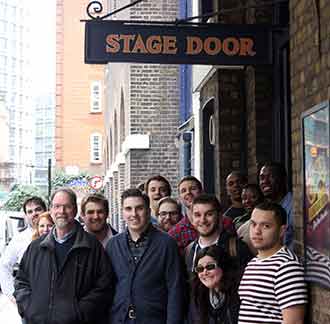 “Another aspect of the area surrounding Hyde Park I enjoyed was seeing the architectural memorials dedicated to horses and other animals that were used in World War I. I was so interested in the memorials because the research project I conducted for the immersion course dealt exclusively with the stage history of War Horse, which is a novel about a horse’s experience in the First World War. The information I researched told me about the deep reverence and respect the English culture had for horses, especially pertaining to their involvement in the war. Visiting the various memorials/statues dedicated to horses reified my understanding of the English culture’s ‘love’ for horses, which were used ubiquitously during the war.” – A.J. Clark ‘16
“Another aspect of the area surrounding Hyde Park I enjoyed was seeing the architectural memorials dedicated to horses and other animals that were used in World War I. I was so interested in the memorials because the research project I conducted for the immersion course dealt exclusively with the stage history of War Horse, which is a novel about a horse’s experience in the First World War. The information I researched told me about the deep reverence and respect the English culture had for horses, especially pertaining to their involvement in the war. Visiting the various memorials/statues dedicated to horses reified my understanding of the English culture’s ‘love’ for horses, which were used ubiquitously during the war.” – A.J. Clark ‘16